ARK Invest’s Big Ideas 2022: The 14 transformative technologies to watch this year | ZDNet
ARK Invest BIG IDEAS 2022 Research Report
ARK Invest solely invests in disruptive innovations. ARK’s thematic investment strategies span market capitalizations, sectors, and geographies to focus on public companies that we expect to be the leaders, enablers, and beneficiaries of disruptive innovation. ARK’s strategies aim to deliver long-term growth with low correlation to traditional investment strategies.
ARK Invest defines “disruptive innovation” as the introduction of a technologically enabled new product or service that potentially changes the way the world works. ARK focuses solely on offering investment solutions to capture disruptive innovation in the public equity markets.
ARK released their annual BIG IDEAS 2022 research report centered around the belief that five innovation platforms are evolving and converging at the same time: Artificial Intelligence, Robotics, Energy Storage, DNA Sequencing, and Blockchain Technology. ARK has identified 14 transformative technologies that are approaching tipping points as costs drop, unleashing demand across sectors and geographies, and spawning more innovation.
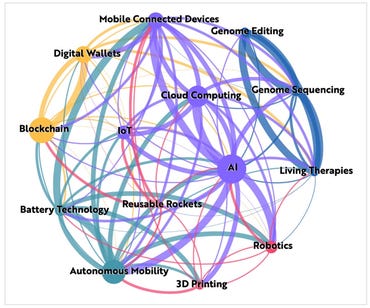
ARK Big Ideas 2022: 14 transformative technologies that are approaching tipping points
ARK Invest
Here are the 14 transformative technologies that are approaching tipping points in the ARK 2022 Big Ideas Report:
- Artificial Intelligence
- Digital Consumer
- Digital Wallets
- Public Blockchains
- Bitcoin
- Ethereum and DeFi
- Web3
- Gene Editing
- Multi-Omics
- Electric Vehicles
- Autonomous Ride-Hail
- Autonomous Logistics
- Printing and Robotics
- Orbital Aerospace
ARK research forecasts that disruptive innovation technologies will grow from a $14 trillion market in 2020 to a $210 trillion market by 2030. ARK research forecast of market capitalizations by 2030:
- AI innovation could increase nearly 10-fold to more than $100 trillion in equity market capitalization by 2030. The research points to AI ($85T) as well as mobile-connected devices ($8T), the internet of things ($4.6T), and cloud computing ($10T) as drivers of AI adoption.
- Battery technology could enable autonomous mobility, generating more than $30 trillion in market capitalization by 2030.
- Robotics advances could generate more than $10 trillion in equity capitalizations by 2030. Technologies like 3D printing ($1.1T), Robotics ($8.6T), and reusable rockets ($500B) contribute to the projections.
- Genomics technologies could drive more than $3 trillion in equity market capitalization by 2030, including gene sequencing ($1.6T), live therapies ($1T), and gene editing ($1T).
- Cryptoassets ($40T) and digital wallets ($9T) to command nearly $50 trillion in equity market capitalization by 2030.
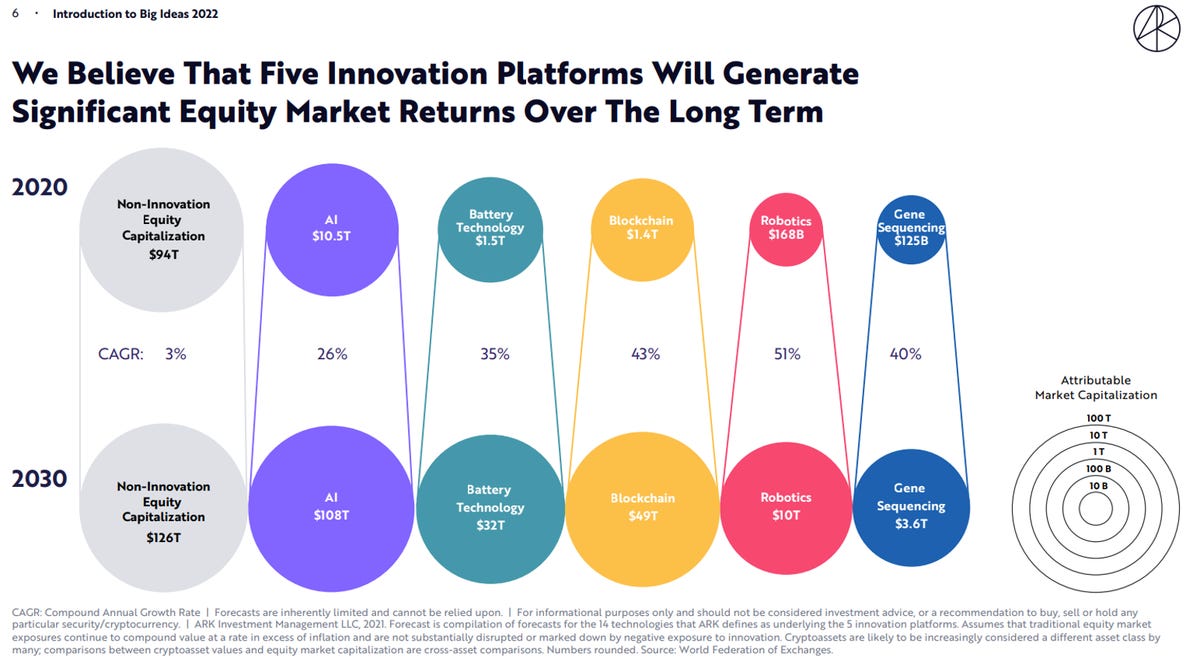
5 innovation platforms are evolving and converging at the same time: Artificial Intelligence, Robotics, Energy Storage, DNA Sequencing, and Blockchain Technology.
Convergence across technologies could amplify their potential. For example, the convergence of robotics, battery technologies, and artificial intelligence is likely to collapse the cost structure of transportation, impacting the economics of auto, rail, and airline activities. Let us take a deeper look at 5 of these critically important transformative technologies in the ARK 2022 report: AI, Digital Consumer, Digital Wallets, Web3, and Electric Vehicles.
Artificial Intelligence (AI)
Per ARK, Artificial Intelligence (AI) training costs appear to be declining at more than twice the rate of Moore’s Law1 as performance is increasing significantly. By automating the tasks of knowledge workers, AI should boost productivity and lower unit labor costs significantly. An example of cost reduction: Given 240 trillion synapses, the cost to train a neural network equivalent in size to the human brain in 2021 would have been $2.5 billion and is likely to drop 60% at an annual rate to $600,000 by 2030.
ARK suggests that the market capitalization of AI hardware and software companies could scale at a roughly 50% annualized rate, increasing from $2.5 trillion in 2021 to $87 trillion by 2030. Based on Write’s Law, ARK forecasts that convergence of hardware and software could drive down AI training costs by 60% at an annual rate by 2030.
ARK suggests that AI could automate the tasks of knowledge workers and boost productivity. ARK’s forecast is that by 2030, AI will increase the output of knowledge workers by 140%.
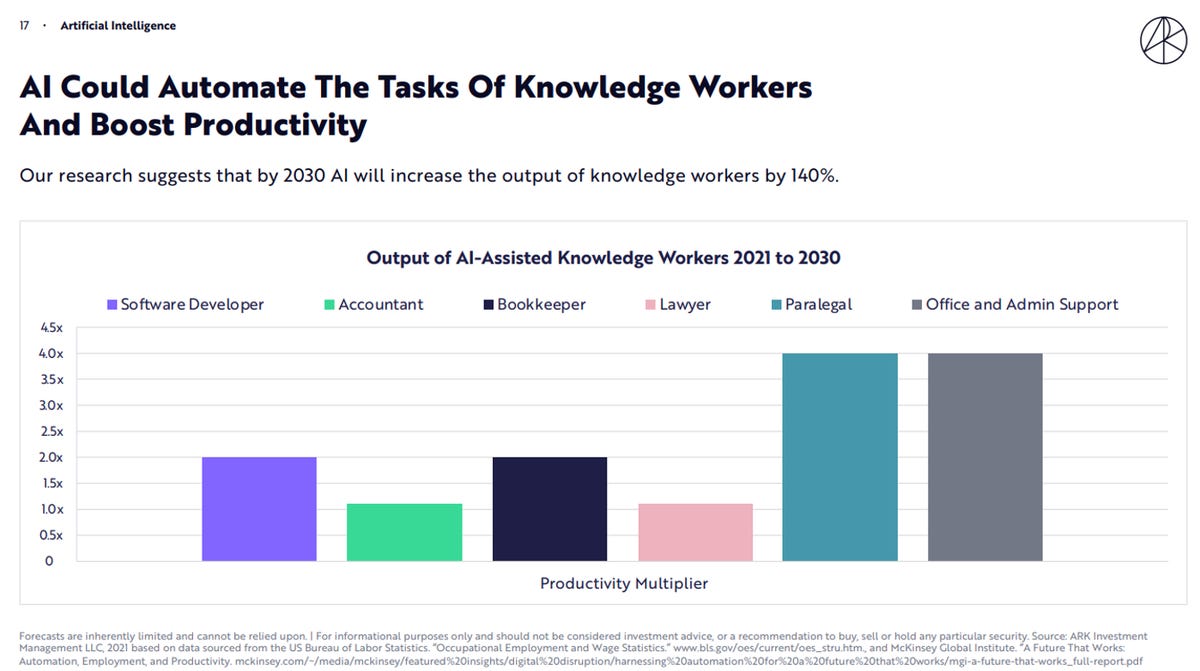
ARK suggests that by 2030 AI will increase the output of knowledge workers by 140%.
By 2030, artificial intelligence is likely to boost the output of global knowledge workers by 9% at an annual rate, from $41 trillion in expected human labor output to roughly $97 trillion in AI + human output.
ARK estimates that organizations will increase spending on enterprise software by 42% at an annual rate of $14 trillion a year. If automation boosts productivity by 140%, AI software could increase the output of global knowledge workers at an annual rate of 9% to $97 trillion in 2030. ARK estimates that SaaS companies spend 50%+ of their cost of goods sold (COGS) on infrastructure hosting costs. As demand for AI software grows, the demand for hardware could rise accordingly.

AI Could Accelerate Productivity Gains
Spending on global AI software and hardware could reach over $20 Trillion by 2030. AI could scale from almost $2.5T to $87T in enterprise value by 2030. By 2030, AI software companies could produce $14 trillion in annual revenue collectively. The resulting $4 trillion in free cash flow could create over $80 trillion in enterprise value, up from $2.3 trillion in 2021, generating returns of 48% at a compound annual rate during the next nine years. By 2030, AI hardware companies could produce $1.7 trillion in annual revenue collectively. The resulting $350 billion in free cash flow could create $7 trillion in enterprise value, generating returns of 57% at a compound annual rate during the next nine years.

Spending On Global AI Software And Hardware Could Be More Than Triple The Consensus Expectation By 2030
Digital Consumers
According to ARK: the new digitally native consumer is spending an increasing amount of time socializing, playing, and purchasing online. As digital takes share in our daily lives, we believe the market — as measured by online entertainment spend, advertising spend, and platform e-commerce fees — is likely to grow at an 18% compound annual rate during the next five years, from $1.8 trillion today to $4.1 trillion in 2026.
ARK estimates that on average in 2021, internet users spent 38% of their free time online and 62% offline. By 2030, we expect these averages to flip, with users spending 52% of their free time online and 48% offline. Social platforms are scaling like never before. The accelerating adoption of online platforms gives businesses and individuals the ability to reach global audiences. Today, 6 platforms have more than 1 billion monthly active users, and 29 platforms have at least 100 million monthly active users.
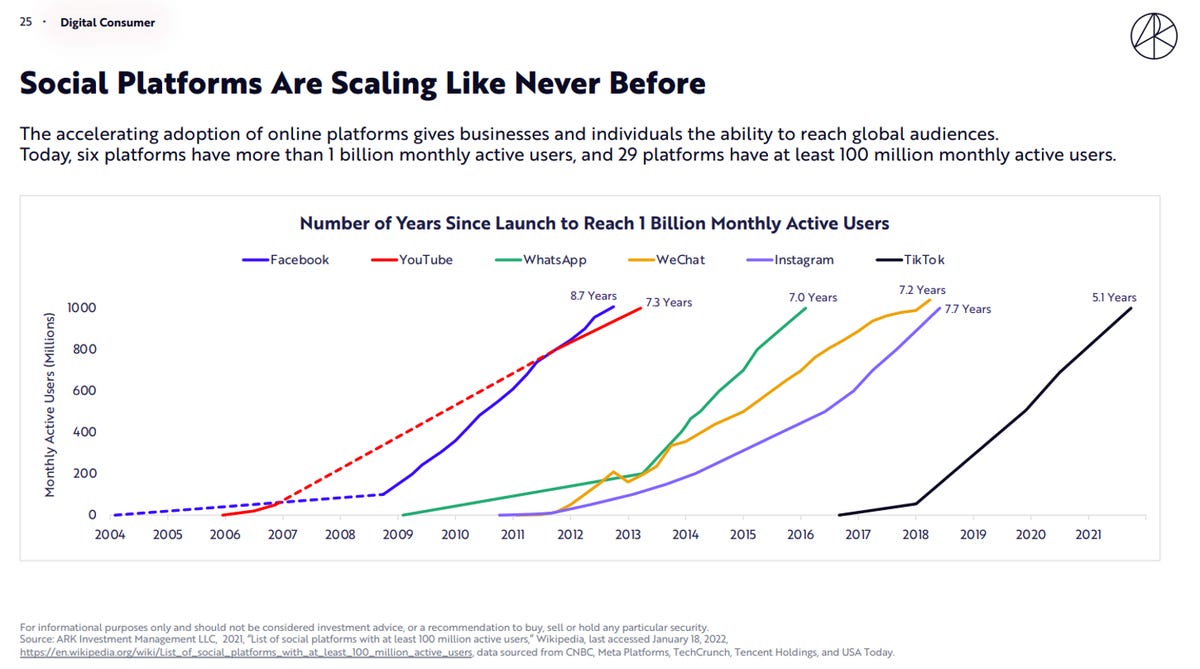
Social Platforms Are Scaling Like Never Before
Digital channels are how businesses are reaching their customers. By the end of 2021, global digital advertising totaled roughly $440 billion, or 62% of the total advertising market. ARK forecasts the global digital advertising market will grow at an 11% compound annual rate over the next eight years, surpassing $1 trillion in expenditures by the end of 2029.
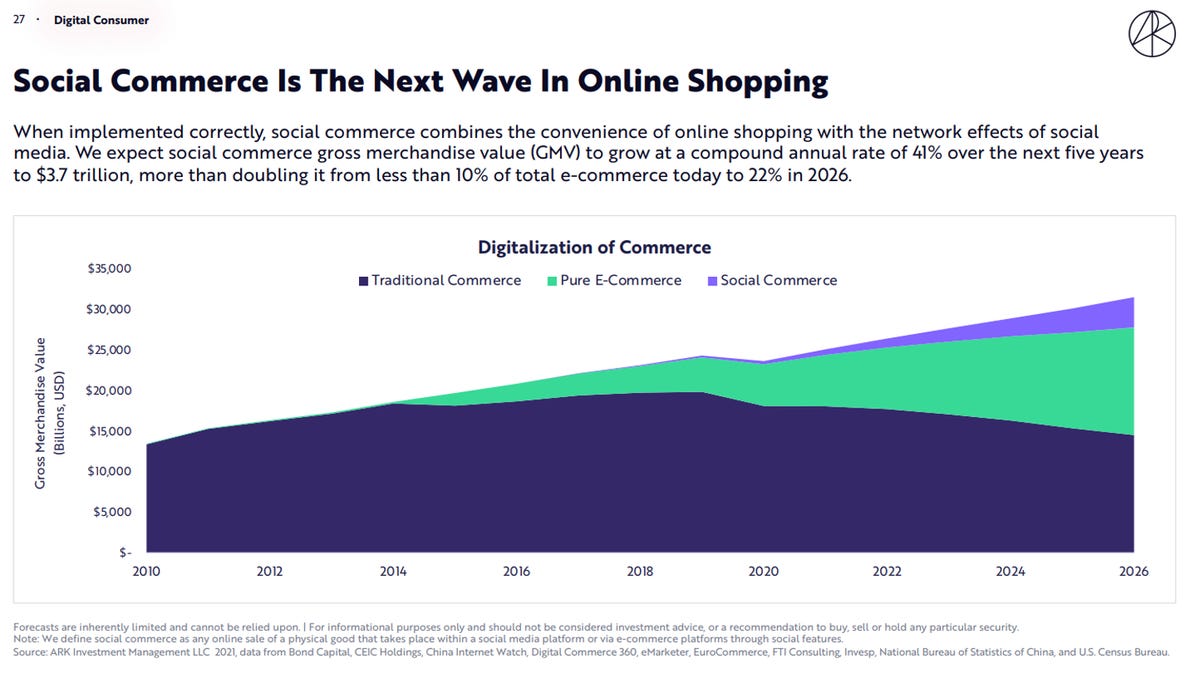
Social Commerce Is The Next Wave In Online Shopping
Social commerce is the next wave in online shopping. When implemented correctly, social commerce combines the convenience of online shopping with the network effects of social media. ARK expects social commerce gross merchandise value (GMV) to grow at a compound annual rate of 41% over the next five years to $3.7 trillion, more than doubling it from less than 10% of total e-commerce today to 22% in 2026. ARK estimates that the revenue associated with discretionary online time will increase from $1.8 trillion today to $4.1 trillion by 2026.
Digital Wallets
Today, digital wallets like Venmo, Cash App, and others around the globe are penetrating traditional financial services, including brokerage and lending, thanks to superior user experiences and much lower costs of acquisition. In ARK’s view, digital wallets could scale at an annual rate of 69% in the US, from more than $400 billion in market capitalization to $5.7 trillion, and 78% globally, from $1.1 to $20 trillion, during the next five years.
Digital wallets are the number one payment method offline and online. Dominating e-commerce payments since 2017, digital wallets surpassed cash last year in point-of-sale (POS) payments, likely in response to the COVID-19 pandemic. The number one digital wallet users have surpassed the number of deposit account holders at one of the largest US banks. Based on publicly available data, Square’s Cash App and PayPal’s Venmo have amassed 74 million and 82 million annual active users in the past 8 and 11 years, respectively. J.P. Morgan hit 60 million deposit account holders after five acquisitions in more than 30 years

Digital Wallets Are The Number One Payment Method Offline And Online
Differentiated customer acquisition strategies result in lower customer acquisition costs. ARK shows a customer acquisition cost variance from $2,500 per customer to $1 (Nubank). ARK estimates that each digital wallet user in the US could be worth $22,500 at maturity. The US digital wallet opportunity could scale 69% at an annual rate of more than $400 billion in 2021 to $5.7 trillion by 2026. The global digital wallet opportunity could scale to 78% at an annual rate from $1.1 trillion to $20 trillion in 2026.
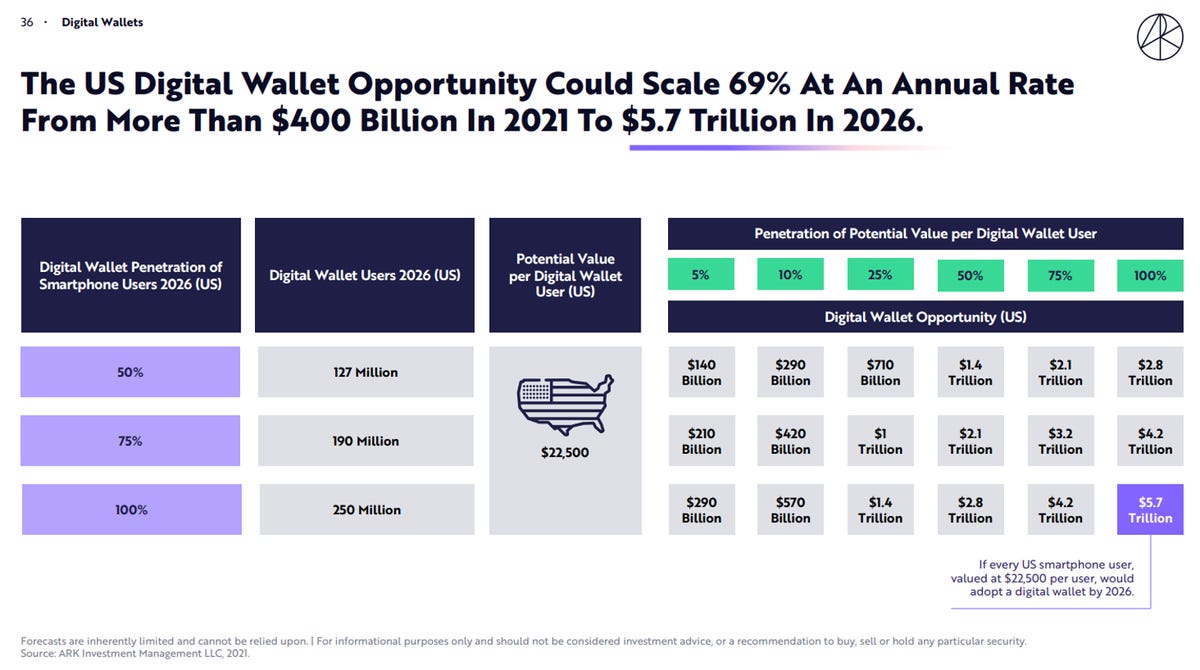
The US Digital Wallet Opportunity Could Scale 69% At An Annual Rate From More Than $400 Billion In 2021 To $5.7 Trillion In 2026
Web3 – An Internet Revolution
Now that consumers are spending more time and resources online, the importance of digital assets is likely to increase considerably as consumer spending shifts to virtual worlds. A global framework like non-fungible tokens (NFTs) provides a stable way of taking the ownership and control of digital assets away from corporations, to the benefit of individuals. By 2030, ARK expects Web3 to depress annual offline consumption by $7.3 trillion, boosting direct online expenditures at an annual rate of 28%, from $1.4 trillion today to $12.5 trillion per year.
Also: What is Web3? Everything you need to know about the decentralized future of the internet
Public blockchains enable the ownership of digital assets. Non-fungible tokens (NFTs) serve as smart contracts that verify the ownership of digital assets on public blockchains. They usurp the power of centralized platforms to house, control, and verify assets. In 2021, NFTs generated $21 billion in sales as the number of monthly unique buyers soared nearly eight-fold to more than 700,000.
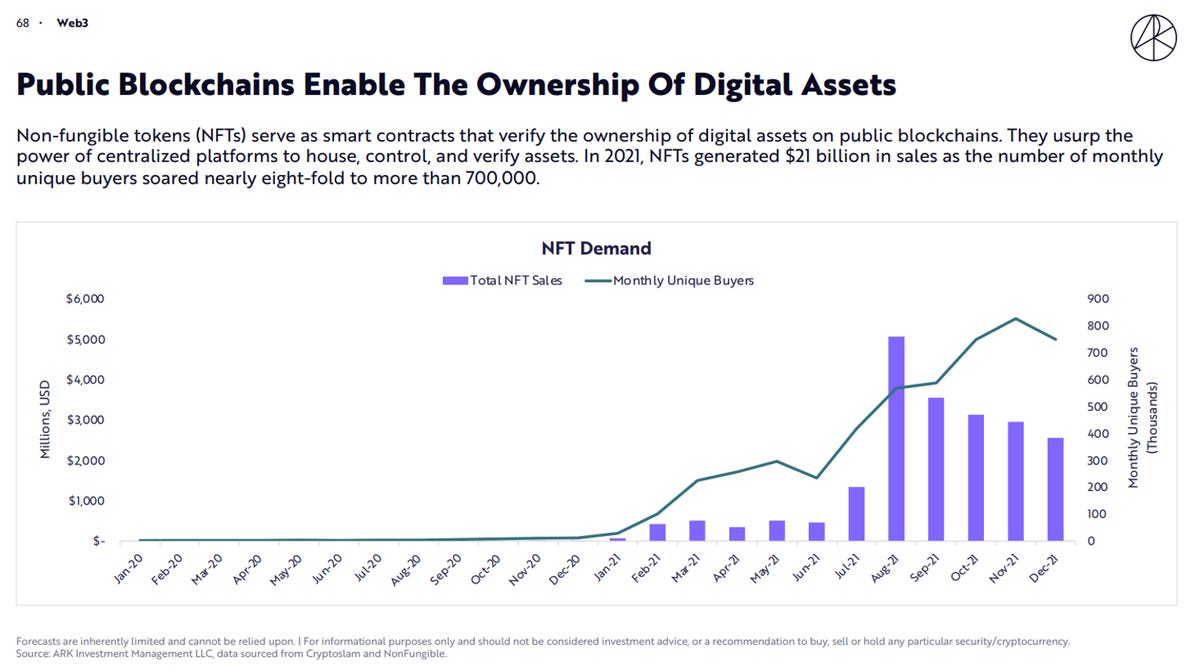
Web3: Public Blockchains Enable The Ownership Of Digital Assets
Public blockchain infrastructure serves as the backbone for new forms of economic coordination: it minimizes the need to trust centralized institutions. The decentralized, open, and permissionless characteristics of public blockchains lower the cost of coordination, among other advantages.
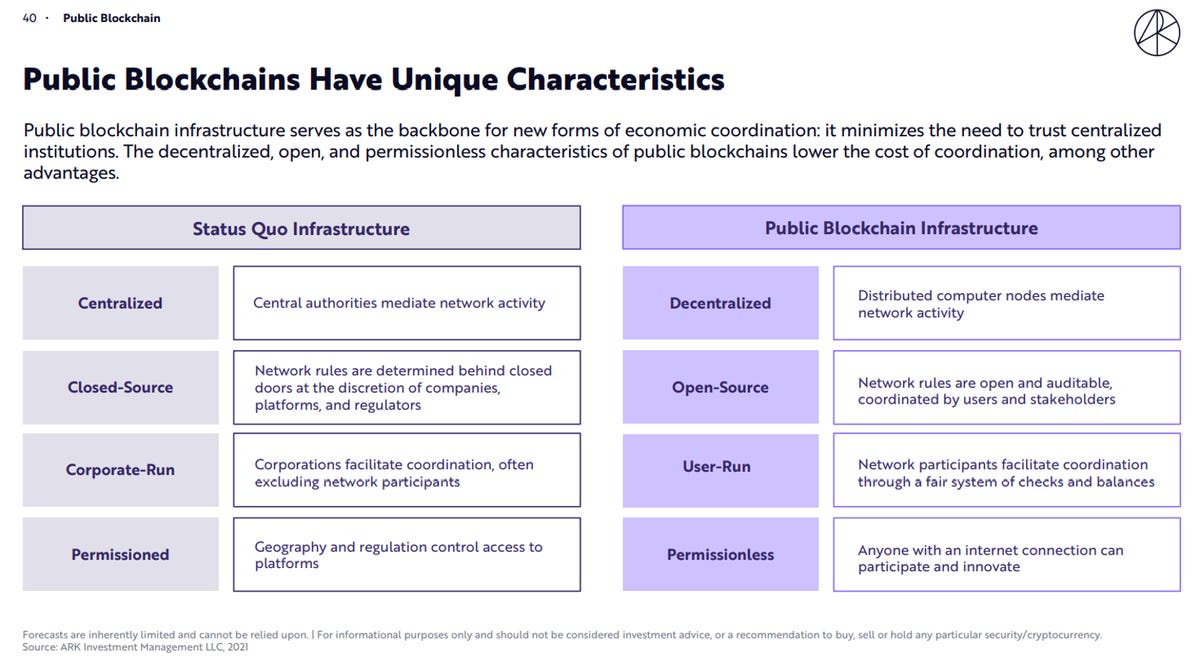
Public Blockchains Have Unique Characteristics – Web 3
Currently, collectibles and digital art account for more than 75% of NFT sales on Ethereum. Based on the evolution of the video gaming market, NFT demand for blockchain-based games and virtual worlds could exceed that for digital collectibles and art, especially as collectibles and art begin to exhibit more utility in various games during the next five to ten years. ARK believes NFTs will blur the lines between consumption and investment.

ARK: NFTs Will Blur The Line Between Consumption And Investment
ARK believes that if Web3 proliferates, the monetization rate of online spending should approach that of offline spending by 2030. ARK research suggests that the monetization of time spent online will grow at a compound annual rate of 19% with Web3 but only 8% without Web3 during the next ten years. Web3 annual online spending could reach $12.5 trillion in the next decade.
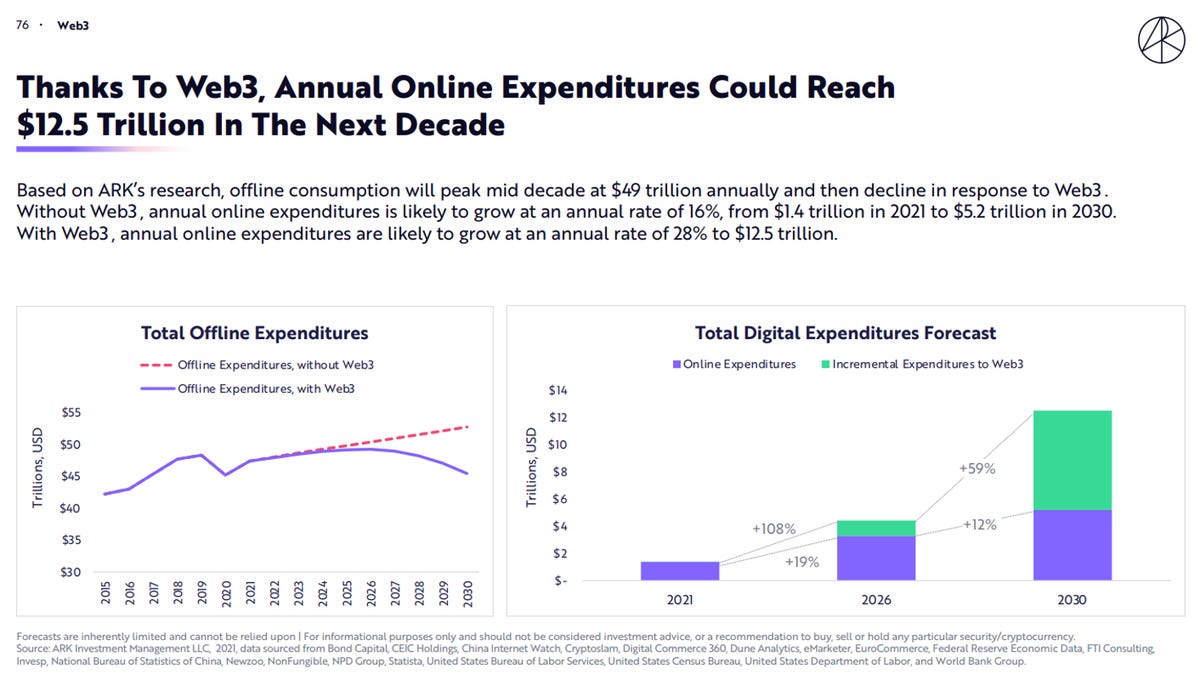
ARK: Thanks to Web3, Annual Online Expenditures Could Reach $12.5 Trillion In The Next Decade
Electric Vehicles
As their range increases, the prices of electric vehicles (EVs) are declining, overcoming the most significant barriers to customer adoption. Based on Wright’s Law, ARK forecasts that EV sales will increase roughly eightfold, or a 53% annual rate, from 4.8 million in 2021 to 40 million units in 2026. According to ARK, the biggest downside risk to our forecast is whether traditional automakers will be able to transition successfully to electric autonomous vehicles.
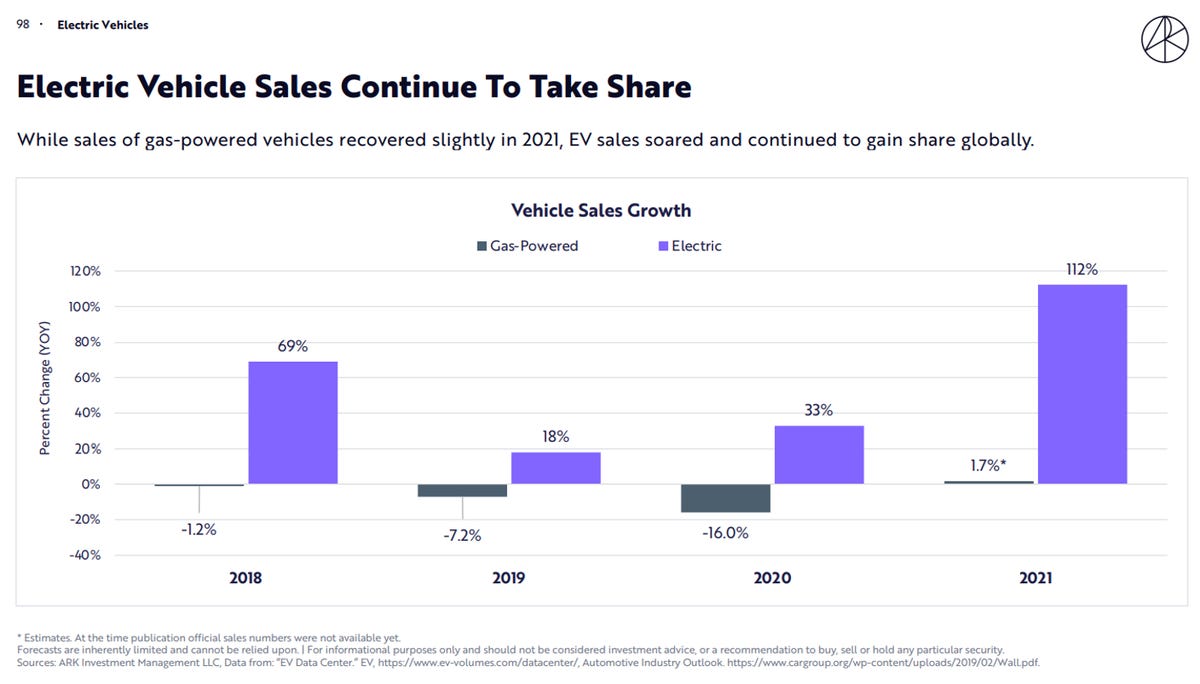
ARK: Electric Vehicle Sales Continue To Take Share
Electric vehicles costs could rival gas-powered options by 2023. The total cost of ownership for a like-for-like EV dropped below that of a Toyota Camry in 2019.1 EV production costs and sticker prices are likely to drop below those of gas-powered vehicles in the next one to two years and undercut them by 25-35% in 2025. ARK’s research shows that the median performance of EVs in 2021 is approaching Tesla’s performance in 2018. Both should continue to improve.
If traditional automakers navigate the shift from gas-powered vehicles successfully, EV sales could scale 8-fold from 4.8 million to 40 million during the next five years.

ARK expects that sales of smaller, cheaper “neighborhood electric vehicles” will take off by 2026.
The ARK Big Ideas Report 2022 is comprehensive research covering five innovation platforms (Artificial Intelligence, Robotics, Energy Storage, DNA Sequencing, and Blockchain Technology) and 14 transformative technologies that are approaching tipping points. I highly recommend that you take the time to review this important research.
For all the latest Technology News Click Here
For the latest news and updates, follow us on Google News.
